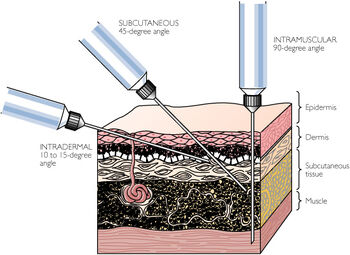
Examples of subcutaneous and intramuscular injections.
|
Because it carries with it a substantial risk of hypoglycemia, [1][2] giving insulin intramuscularly should only be done with guidance from a medical professional. Insulins which are not soluble are able to be used intramuscularly, unlike intravenously, which requires soluble insulins only. | ||
Intramuscular insulin injection is a technique used for both pets and people in an effort to hasten onset, compared to the usual technique of injecting subcutaneously. [3] It's often referred to medically by the abbreviation IM. [4]
Because absorption of subcutaneous insulin can be altered by dehydration (mainly slower than normal), intramuscular insulin injections can be used for cases involving dehydration and/or ketoacidosis. [5]
References
- ↑ Thow JC, Johnson AB, Fulcher G, Home PD. (1990). Different Absorption of Isophane (NPH) Insulin From Subcutaneous and Intramuscular Sites. Diabetic Medicine.
- ↑ Insulin Treatment-Needle and Syringe. Patients Up To Date.
- ↑ Questions About Insulin. Diabetes-World Mailing List.
- ↑ Heinemann, Lutz (January 2008). Variability of Insulin Action:Does It Matter?-page 40 (4 of 9). Insulin Journal.
- ↑ Herrtage, Michael (2009). New Strategies in the Management of Canine Diabetes Mellitus. WSAVA.
More Information
- Variation in Absorption of NPH Insulin Due to Intramuscular Injection Diabetes Care-1990